출혈 지혈 방법, How to stop bleeding
-
출혈(Bleeding/hemorrhaging)은 몇 방울 정도 피부층이나 피하에서 나는 외출혈,
-
동맥이나 정맥이 잘려서 상당한 많이 나는 내출혈, 외출혈 또는 내·외출혈도 있고
-
신체 내부에서 신체 외부로 나는 외출혈,
-
또는 신체의 내부에서 그 주위에 있는 신체 내부로 나는 내출혈 등이 있다.
-
급성 출혈, 만성 출혈 등 여러 종류의 출혈이 있다.
-
그 출혈의 종류에 따라 지혈 방법도 많이 다르다.
-
혈우병 등 유전성 출혈 질환으로 출혈이 생길 수 있다.
-
특발성 혈소판 감소성 자반증 등 후천성, 전신, 출혈성 질병이 있을 때도 정상 이상으로 출혈할 수 있다.
-
정상 이상으로 출혈 하면 응급으로 출혈을 지연시키는 동시에 원인에 따라 치료해야 한다. 원인이 무엇이든지 출혈을 하면 응급으로 지혈 치료를 먼저 하고,
-
필요에 따라 CBC 피 검사, 혈액 응고 인자 검사, 프로스롬빈 시간(Prothrombin time /PT), 부분적 트롬보플라스틴 시간(PTT), 출혈 시간 검사로 원인을 알아야 할 때도 있다(표 20 참조).
-
손가락으로 코를 쑤셔 코피가 날 수 있다.
-
이때는 코의 앞 말랑말랑한 부분(비익)을 엄지와 인지로 살짝 잡으면 지혈되는 것이 보통이다.
-
또는 병원에서 아드레날린제 액을 2방울 묻힌 솜 덩어리로 콧구멍 속(비강 속)에 넣으면 대개 코피기 멈춘다.
-
때로는 이비인후과에서 초산 은봉으로 비강 점막층 모세 혈관을 지져 치료 할 수 있다.
-
혈소판 감소증, 혈우병 등으로 코피가 날 수 있다. 이때 두 손가락으로 코를 전술 한 것 같이 잡아 지혈시키고 의사의 전화 상담 지시에 따라 추적 치료를 받는다.
-
편도 수술 치료를 받은 이후나 아데노이드 수술 치료를 받은 후 코피가 날 수 있고 입 안에서 피가 날 수 있다. 이때도 역시 의사의 지시에 따라 치료한다.
-
절상, 열상, 찢긴 상처, 찢김, 열창 등 외부 외상으로 생긴 외출혈은 그 상처의 크기에 따라, 신체 부위에 따라, 출혈의 정도에 따라 다음 사진 204~210에서 볼 수 있는 지혈 치료와 같이 손가락 압박, 손 바닥 압박, 봉합수술 치료 등으로 지혈시킬 수 있다.
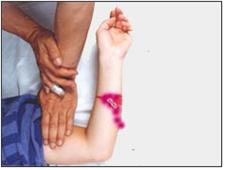
사진 201. 출혈될 때 나는 피를 공급하는 팔이나 다리 등에 있는 동맥을 손가락이나 손으로 꼭 눌러 지혈시킬 수 있다.
Copyright ⓒ 2012 John Sangwon Lee, MD., FAAP

사진 202. 팔이나 다리에서 피가 많이 날 때는 피가 나는 상처 부분을 손으로 직접 꼭 눌러 지혈하고 그와 동시 출혈 부분에서 심장이 있는 쪽으로 조금 떨어진 팔이나 다리의 한 부분을 붕대나 지혈대 등으로 매어 지혈할 수 있다. 지혈대로 매서 지혈시키는 응급처치법은 다른 지혈 방법으로 지혈시킬 수 없는 응급한 경우에 쓰는 지혈 응급처치방법이다.
Copyright ⓒ 2012 John Sangwon Lee, MD., FAAP
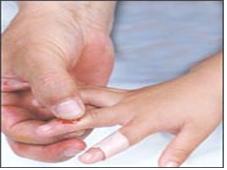
사진 204. 손가락이나 손으로 피나는 상처 부분을 직접 꼭 눌러 지혈시키거나 밴드를 붙이거나 붕대를 감아 지혈시킬 수 있다. Copyright ⓒ 2012 John Sangwon Lee, MD., FAAP
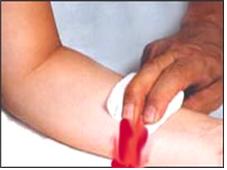
사진 205. 피가 나는 상처 부분을 손가락이나 손바닥으로 꼭 눌러 지혈시킬 수 있다
Copyright ⓒ 2012 John Sangwon Lee, MD., FAAP
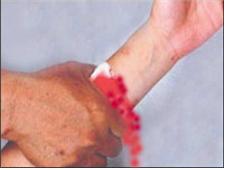
사진 206. 상처 부분에 거즈 등을 올려놓고 손바닥이나 손가락으로 상처를 직접 꼭 눌러 지혈시킬 수 있다
Copyright ⓒ 2012 John Sangwon Lee, MD., FAAP

사진 207. 상처에 거즈 등을 올려놓고 손으로 상처를 직접 꼭 눌러 지혈시킬 수 있다
Copyright ⓒ 2012 John Sangwon Lee, MD., FAAP
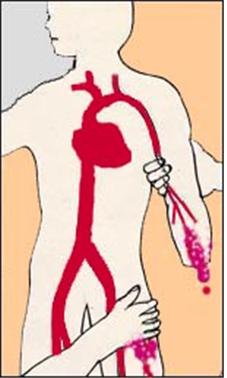
그림 210. 피나는 상처를 손가락 끝이나 손으로 직접 꼭 눌러 지혈시켜도 피가 계속 나면 출혈되는 피를 공급해 주는 동맥을 손으로 꼭 눌러 지혈할 수 있다.
Copyright ⓒ 2012 John Sangwon Lee, MD., FAAP
How to stop bleeding
Bleeding/hemorrhaging is a few drops of external blood from the skin layer or subcutaneously;
• There is also significant internal bleeding, external bleeding, or internal/external bleeding due to cutting of an artery or vein.
• Outgoing blood from the inside of the body to the outside of the body;
• or internal bleeding from the inside of the body to the inside of the body around it.
• There are several types of bleeding, including acute bleeding and chronic bleeding
. • The method of hemostasis varies greatly depending on the type of bleeding.
• Hereditary bleeding disorders, such as hemophilia, can cause bleeding. • Abnormal bleeding may occur even with acquired, systemic, or hemorrhagic diseases such as idiopathic thrombocytopenic purpura.
• In case of abnormal bleeding, it is necessary to delay the bleeding as an emergency and treat it according to the cause. Whatever the cause, if bleeding occurs, first aid in hemostasis treatment, • If necessary, the cause may need to be determined by a CBC blood test, blood clotting factor test, prothrombin time (PT), partial thromboplastin time (PTT), and bleeding time test (see Table 20).
• Stinging your nose with your finger can cause nosebleeds.
• In this case, it is common to stop bleeding by lightly holding the soft front part of the nose (fly) with your thumb and forefinger.
• Or, if you put 2 drops of adrenaline solution into the nostrils (in the nasal passages) with a cotton ball at the hospital, nosebleeds usually stop.
• Sometimes otolaryngology can treat the nasal mucosal capillaries with silver acetate rods. • Nosebleeds may occur due to thrombocytopenia or hemophilia. At this time, hold the nose with two fingers as described above to stop bleeding and follow-up treatment according to the doctor’s telephone consultation instructions.
• You may have nosebleeds and bleeding from your mouth after tonsillectomy or adenoid surgery. At this time, also treat according to the doctor’s instructions. • External bleeding caused by external trauma such as cuts, lacerations, torn wounds, torns, and fissures depends on the size of the wound, body part, and the degree of bleeding. Hemostasis can be stopped with palmar compression, suture treatment, etc.

Picture 201. When I bleed, I can stop the bleeding by pressing the artery in the arm or leg that supplies blood with my finger or hand. Copyright ⓒ 2012 John Sangwon Lee, MD., FAAP

Photo 202. When there is a lot of bleeding from the arm or leg, press directly on the bleeding wound with your hand to stop hemostasis. can bleed The first aid method for hemostasis by tying a tourniquet is an emergency treatment method for hemostasis that cannot be stopped by other hemostatic methods. Copyright ⓒ 2012 John Sangwon Lee, MD., FAAP

Photo 204. You can stop bleeding by directly pressing the bleeding wound with your finger or hand, or you can apply a bandage or bandage to stop the bleeding. Copyright ⓒ 2012 John Sangwon Lee, MD., FAAP

Photo 205. You can stop bleeding by pressing the bleeding wound with your finger or palm. Copyright ⓒ 2012 John Sangwon Lee, MD., FAAP

Photo 206. You can stop bleeding by placing gauze on the wound and directly pressing the wound with your palm or fingers. Copyright ⓒ 2012 John Sangwon Lee, MD., FAAP

Photo 207. You can stop bleeding by putting gauze on the wound and pressing the wound directly with your hand. Copyright ⓒ 2012 John Sangwon Lee, MD., FAAP

Figure 210. If bleeding continues even if you press the bleeding wound directly with your fingertips or your hand, you can stop the bleeding by pressing the artery that supplies the bleeding blood with your hand. Copyright ⓒ 2012 John Sangwon Lee, MD., FAAP
출처와 참조 문헌 Sources and references
- NelsonTextbook of Pediatrics 22ND Ed
- The Harriet Lane Handbook 22ND Ed
- Growth and development of the children
- Red Book 32nd Ed 2021-2024
- Neonatal Resuscitation, American Academy Pediatrics
- www.drleepediatrics.com 제1권 소아청소년 응급 의료
- www.drleepediatrics.com 제2권 소아청소년 예방
- www.drleepediatrics.com 제3권 소아청소년 성장 발육 육아
- www.drleepediatrics.com 제4권 모유,모유수유, 이유
- www.drleepediatrics.com 제5권 인공영양, 우유, 이유식, 비타민, 미네랄, 단백질, 탄수화물, 지방
- www.drleepediatrics.com 제6권 신생아 성장 발육 육아 질병
- www.drleepediatrics.com제7권 소아청소년 감염병
- www.drleepediatrics.com제8권 소아청소년 호흡기 질환
- www.drleepediatrics.com제9권 소아청소년 소화기 질환
- www.drleepediatrics.com제10권. 소아청소년 신장 비뇨 생식기 질환
- www.drleepediatrics.com제11권. 소아청소년 심장 혈관계 질환
- www.drleepediatrics.com제12권. 소아청소년 신경 정신 질환, 행동 수면 문제
- www.drleepediatrics.com제13권. 소아청소년 혈액, 림프, 종양 질환
- www.drleepediatrics.com제14권. 소아청소년 내분비, 유전, 염색체, 대사, 희귀병
- www.drleepediatrics.com제15권. 소아청소년 알레르기, 자가 면역질환
- www.drleepediatrics.com제16권. 소아청소년 정형외과 질환
- www.drleepediatrics.com제17권. 소아청소년 피부 질환
- www.drleepediatrics.com제18권. 소아청소년 이비인후(귀 코 인두 후두) 질환
- www.drleepediatrics.com제19권. 소아청소년 안과 (눈)질환
- www.drleepediatrics.com 제20권 소아청소년 이 (치아)질환
- www.drleepediatrics.com 제21권 소아청소년 가정 학교 간호
- www.drleepediatrics.com 제22권 아들 딸 이렇게 사랑해 키우세요
- www.drleepediatrics.com 제23권 사춘기 아이들의 성장 발육 질병
- www.drleepediatrics.com 제24권 소아청소년 성교육
- www.drleepediatrics.com 제25권 임신, 분만, 출산, 신생아 돌보기
- Red book 29th-31st edition 2021
- Nelson Text Book of Pediatrics 19th- 21st Edition
- The Johns Hopkins Hospital, The Harriet Lane Handbook, 22nd edition
- 응급환자관리 정담미디어
- Pediatric Nutritional Handbook American Academy of Pediatrics
- 소아가정간호백과–부모도 반의사가 되어야 한다, 이상원 저
- The pregnancy Bible. By Joan stone, MD. Keith Eddleman, MD
- Neonatology Jeffrey J. Pomerance, C. Joan Richardson
- Preparation for Birth. Beverly Savage and Dianna Smith
- 임신에서 신생아 돌보기까지. 이상원
- Breastfeeding. by Ruth Lawrence and Robert Lawrence
- Sources and references on Growth, Development, Cares, and Diseases of Newborn Infants
- Emergency Medical Service for Children, By Ross Lab. May 1989.
- Emergency care, Harvey Grant and Robert Murray
- Emergency Care Transportation of Sick and Injured American Academy of Orthopaedic Surgeons
- Emergency Pediatrics A Guide to Ambulatory Care, Roger M. Barkin, Peter Rosen
- Quick Reference To Pediatric Emergencies, Delmer J. Pascoe, M.D., Moses Grossman, M.D. with 26 contributors
- Neonatal resuscitation Ameican academy of pediatrics
- Pediatric Nutritional Handbook American Academy of Pediatrics
- Pediatric Resuscitation Pediatric Clinics of North America, Stephen M. Schexnayder, M.D.
- Pediatric Critical Care, Pediatric Clinics of North America, James P. Orlowski, M.D.
- Preparation for Birth. Beverly Savage and Dianna Smith
- Infectious disease of children, Saul Krugman, Samuel L Katz, Ann A.
- 제4권 모유, 모유수유, 이유 참조문헌 및 출처
- 제5권 인공영양, 우유, 이유, 비타민, 단백질, 지방 탄수 화물 참조문헌 및 출처
- 제6권 신생아 성장발육 양호 질병 참조문헌 및 출처
- Clinical Atlas of Blood Diseases, Sixth Edition, A. Piney, M.D., and Stanley Wyard M.D., The Blakiston Co
- Hematologic Problems in The Newborn, Third Edition, Volume IV in the series, Major Problems in Clinical Pediatrics, Oski and Naiman, W.B. Saunders.
- Pediatric Hematology, The Pediatric Clinics of North America, June 1996, W.B. Saunders
- Pediatric Hematology, The Pediatric Clinics of North America, May 1980, W.B. Saunders
- 소아과학 대한교과서
- 의학 용어사전 대한 의사 협회
Copyright ⓒ 2014 John Sangwon Lee, MD., FAAP
“부모도 반의사가 되어야 한다”-내용은 여러분들의 의사로부터 얻은 정보와 진료를 대신할 수 없습니다.
“The information contained in this publication should not be used as a substitute for the medical care and advice of your doctor. There may be variations in treatment that your doctor may recommend based on individual facts and circumstances.
“Parental education is the best medicine.